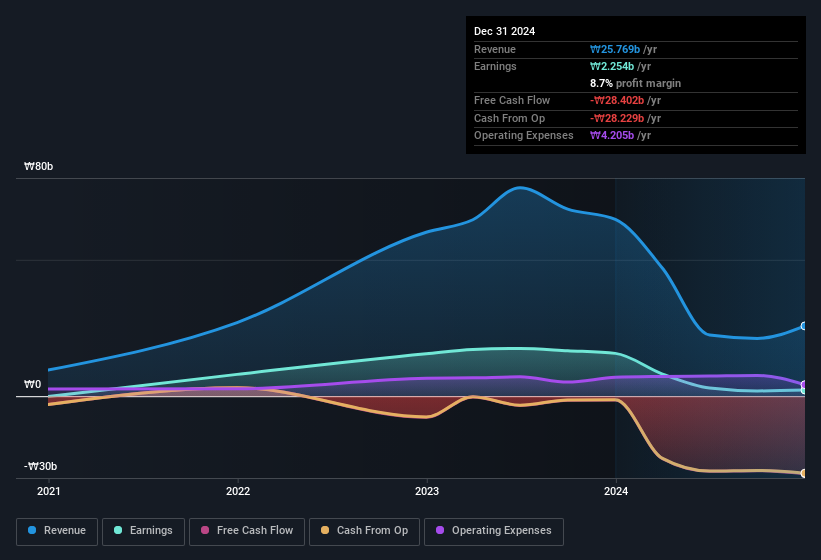- South Korea
- /
- Commercial Services
- /
- KOSDAQ:A448280
Shaky Earnings May Not Tell The Whole Story For Ecoeye (KOSDAQ:448280)

Ecoeye Co., Ltd. (KOSDAQ:448280) recently posted soft earnings but shareholders didn't react strongly. We did some digging, and we believe that investors are missing some worrying factors underlying the profit figures.

A Closer Look At Ecoeye's Earnings
As finance nerds would already know, the accrual ratio from cashflow is a key measure for assessing how well a company's free cash flow (FCF) matches its profit. To get the accrual ratio we first subtract FCF from profit for a period, and then divide that number by the average operating assets for the period. This ratio tells us how much of a company's profit is not backed by free cashflow.
That means a negative accrual ratio is a good thing, because it shows that the company is bringing in more free cash flow than its profit would suggest. While having an accrual ratio above zero is of little concern, we do think it's worth noting when a company has a relatively high accrual ratio. Notably, there is some academic evidence that suggests that a high accrual ratio is a bad sign for near-term profits, generally speaking.
For the year to December 2024, Ecoeye had an accrual ratio of 0.37. Statistically speaking, that's a real negative for future earnings. To wit, the company did not generate one whit of free cashflow in that time. Even though it reported a profit of ₩2.25b, a look at free cash flow indicates it actually burnt through ₩28b in the last year. We also note that Ecoeye's free cash flow was actually negative last year as well, so we could understand if shareholders were bothered by its outflow of ₩28b. However, that's not all there is to consider. The accrual ratio is reflecting the impact of unusual items on statutory profit, at least in part.
See our latest analysis for Ecoeye
Note: we always recommend investors check balance sheet strength. Click here to be taken to our balance sheet analysis of Ecoeye.
How Do Unusual Items Influence Profit?
Given the accrual ratio, it's not overly surprising that Ecoeye's profit was boosted by unusual items worth ₩177m in the last twelve months. While it's always nice to have higher profit, a large contribution from unusual items sometimes dampens our enthusiasm. When we analysed the vast majority of listed companies worldwide, we found that significant unusual items are often not repeated. And that's as you'd expect, given these boosts are described as 'unusual'. Ecoeye had a rather significant contribution from unusual items relative to its profit to December 2024. As a result, we can surmise that the unusual items are making its statutory profit significantly stronger than it would otherwise be.
Our Take On Ecoeye's Profit Performance
Summing up, Ecoeye received a nice boost to profit from unusual items, but could not match its paper profit with free cash flow. Considering all this we'd argue Ecoeye's profits probably give an overly generous impression of its sustainable level of profitability. If you'd like to know more about Ecoeye as a business, it's important to be aware of any risks it's facing. To that end, you should learn about the 5 warning signs we've spotted with Ecoeye (including 3 which are potentially serious).
Our examination of Ecoeye has focussed on certain factors that can make its earnings look better than they are. And, on that basis, we are somewhat skeptical. But there are plenty of other ways to inform your opinion of a company. Some people consider a high return on equity to be a good sign of a quality business. While it might take a little research on your behalf, you may find this free collection of companies boasting high return on equity, or this list of stocks with significant insider holdings to be useful.
Valuation is complex, but we're here to simplify it.
Discover if Ecoeye might be undervalued or overvalued with our detailed analysis, featuring fair value estimates, potential risks, dividends, insider trades, and its financial condition.
Access Free AnalysisHave feedback on this article? Concerned about the content? Get in touch with us directly. Alternatively, email editorial-team (at) simplywallst.com.
This article by Simply Wall St is general in nature. We provide commentary based on historical data and analyst forecasts only using an unbiased methodology and our articles are not intended to be financial advice. It does not constitute a recommendation to buy or sell any stock, and does not take account of your objectives, or your financial situation. We aim to bring you long-term focused analysis driven by fundamental data. Note that our analysis may not factor in the latest price-sensitive company announcements or qualitative material. Simply Wall St has no position in any stocks mentioned.
About KOSDAQ:A448280
Flawless balance sheet moderate.
Market Insights
Community Narratives


